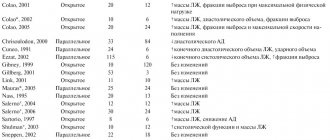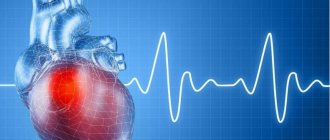Causes of functional disorders of the cardiovascular system
Nowadays, there are many reasons that can lead to the acquisition of the Federal Tax Service. The cause of this disease can be the harmful effects of various factors on the human nervous system. Our body is one whole, and the fact that negative influences on the nervous system lead to changes in the functioning of the entire organism has long been no secret.
The reason for the FTS may be factors such as:
- Impact of chronic diseases
- Improper lifestyle (disturbance in daily routine, poor sleep, etc.)
- Depression
- Severe stress
- Heredity
What are cardiovascular diseases?
Cardiovascular diseases (CVD) are the leading cause of mortality in many economically developed countries, including Russia, accounting for 55% of total mortality.
According to statistics from recent years, in the structure of mortality from CVD, 85.5% are due to ischemic heart disease (46.8%) and cerebral stroke (38.7%). In the Russian Federation in 2000, the mortality rate from diseases of the circulatory system was 800.9 per 100,000 thousand population. The main cause of cardiovascular disease is atherosclerosis. And although it is impossible to eliminate many risk factors for the development of atherosclerosis, we can change, for example, our lifestyle and diet.
Natural age-related “wear and tear” of blood vessels creates conditions for cholesterol deposition inside and on the walls of arteries. This leads to a gradual narrowing of the lumen of the blood vessels and reduces the ability of the heart to pump blood through them to the body. The moment the vessel is completely blocked, a heart attack (myocardial infarction) or stroke occurs if the blockage occurs in a vessel in the brain. It is important to note that high blood cholesterol does not always have an unfavorable prognosis. The fact is that cholesterol is associated with proteins - proteins, together they make up lipoproteins. So, cholesterol can be in high (HDL-CHOL.) and low (LDL-CHOL.) density lipoproteins. Cholesterol in HDL-CHOL. prevents the progression of atherosclerosis - “beneficial lipoproteins”, and cholesterol in LDL-CHOL. promotes the progression of atherosclerosis.
Symptoms of functional disorders of the cardiovascular system
Symptoms of FNS include increased sweating, pallor or slight redness of the skin on the face, periodic fainting, headache, paroxysmal or constantly increased beating of the heart muscle (tachycardia), tachypnea, heaviness and pressure in the chest, impaired blood pressure, shortness of breath. The patient may also experience rapid fatigue, decreased attention and memory, be overly hot-tempered, irritable, suffer from insomnia and experience a constant state of anxiety. There may be various jumps in body temperature (from 35 to 37-38 degrees), nausea, vomiting, belching, diarrhea, frequent urination, anorgasmia with normal sexual desire, constipation. All this signals the Federal Tax Service.
Risk factors for cardiovascular disease
Some risk factors for cardiovascular disease are potentially reversible or can be changed. They include:
- Smoking cigarettes
- Elevated LDL (low density) cholesterol levels
- High triglyceride levels in the blood
- Low HDL (high density) cholesterol
- Overweight
- Large waist circumference (“apple shape”)
- High blood pressure
- Sedentary lifestyle
- Diabetes
Treatment of functional disorders of the cardiovascular system
Healing from this disease implies complex and individual therapy, which is carried out only under the close supervision of a cardiologist, neurologist and always a psychotherapist. Treatment of a functional disorder of the cardiovascular system depends on the manifestation of symptoms in the patient. It is recommended to avoid stressful situations, proper rest and good nutrition are recommended. Massage, water treatments and reflexology are also prescribed. It is possible to prescribe medications: lemon balm, St. John's wort, valerian, motherwort, glycine, antidepressants, glutamic acid.
Publications in the press
Cardiovascular diseases are the leading cause of death in the world. Risk factors for heart disease and stroke include high blood pressure, cholesterol and blood glucose levels, smoking, insufficient consumption of vegetables and fruits, increased weight, and a sedentary lifestyle.
In our area, the incidence of cardiovascular diseases ranks first among other diseases. Thus, according to the results of 2014, hypertension is the leader among CVDs. On the “D” register there are 3096 people with diseases of the circulatory system, 2081 people with hypertension, 5 people with AMI, 764 people with coronary artery disease. Among diseases of the cardiovascular system (including cerebrovascular pathology with stroke), primary disability was 47 cases, which is 48% of the total. Over the course of 3 years, there has been a steady increase in dyscirculatory encephalopathy and stroke, and these are the consequences of hypertension. The first place among the causes of mortality for the entire population of the region is diseases of the cardiovascular system, among them IHD is the leader. I would like to talk about some of the symptoms of these terrible diseases. Sometimes, even at the first glance at a “heart” patient, you can determine the disease from which he suffers.
In case of heart failure (in mild cases), patients prefer to sleep on the right side, since lying on the left causes them discomfort in the heart area.
With left ventricular failure, patients prefer a sitting position.
With chronic insufficiency P-P1, patients prefer to sit with their legs down. The legs usually swell, but shortness of breath bothers the patient less.
Patients with vascular insufficiency feel much better in a horizontal position.
The complexion of a “heart” patient can also tell a lot to an attentive observer: pallor of the skin is often observed with anemia or spasm of superficial vessels, severe rheumatic carditis or aortic valve insufficiency. During collapse, the patient is always pale.
Cyanosis (blueness) of the lips, nose, tip of the tongue, limbs, and earlobes is most often observed in severe degrees of pulmonary heart failure.
Edema in heart disease begins to appear in cases where the heart can no longer cope with the increased load on it and decompensation occurs. The location of the edema depends on the position in which the patient is: in walking patients the edema is located on the soles of the feet and in the shins, in bedridden patients - in the lumbar and back areas. The main cause of edema is an increase in pressure in the venous capillaries. This leads to the fact that while blood is intensively leaking from the arterial limb into the tissues, its reabsorption from the tissues is difficult due to the increased pressure in the venous limb of the capillaries. The occurrence of cardiac edema is also promoted by:
-Poor excretion of table salt by the kidneys, which is abundantly deposited in the tissues.
-Increasing the permeability of the vascular wall.
-Increasing the reabsorption of water by the kidney tubules.
Dyspnea. In heart disease, shortness of breath is one of the earliest symptoms. In mild cases, it bothers the patient only during physical activity, in moderate diseases - when doing normal work, and in severe cases it appears even at rest.
The appearance of shortness of breath in diseases of the cardiovascular system can be explained by several reasons:
- Stagnation in the pulmonary circulation.
- Disorder of cerebral blood supply and hypoxemia (insufficient oxygen supply to the brain).
Heartbeat is the subjective sensation of heart contractions. In a practically healthy person, a rapid heartbeat may occur during physical activity, after a heavy meal, or during stressful conditions. In diseases of the cardiovascular system, palpitations appear already in the early stages of the disease. Often, palpitations are the result of cardiac neuroses and occur with increased excitability of the heart.
Pain. In a healthy person, pain in the heart area can also occur with increased excitability of the nervous system, but more often it is the result of a pathological process. Pain is the guard of our body, and when the guard gives a signal, it means there is a malfunction somewhere. If pain occurs as a result of spasm of the coronary vessels, then it is called angina. In these cases, acute anemia of the myocardium develops, and the pain is the “cry of the starving myocardium.” Angina pain is burning, squeezing or pressing in nature. With inflammation of the membranes of the heart, the pain can be constant and dull. In diseases of the aorta, it is also dull and permanent and is felt behind the sternum.
Dizziness. Dizziness and headaches are often accompanying poor circulation. This is explained by insufficient blood supply to the brain with oxygen and irritation of its nerve endings by decay products.
Chills. Fever. Fever and increased temperature in heart disease occur during inflammatory processes (endocarditis, pericarditis, myocarditis) and when the brain is irritated by decay products during myocardial infarction, thrombophlebitis or pulmonary infarction.
If you experience any of these symptoms, you should contact your doctor promptly.
General practitioner N.V. Tupikina
// Source: https://uzalo48.lipetsk.ru/node/6673
Endocrine system
This is a system that controls and regulates the functioning of the internal organs of the body. Its job is to produce hormones, thanks to which the coordination and control of the activities of other systems and organs of our body occurs. This is how the human body adapts to changes in the external environment and maintains homeostasis (constancy of state) inside. The development of the human body, reproductive function, energy balance, and the emotional and mental state of the individual also depend on the correct functioning of the endocrine system.
The endocrine system consists of the glandular system, which includes the endocrine glands (thymus, thyroid, paraganglia, pituitary gland, pineal gland, adrenal glands, gonads, pancreas and parathyroid) and the diffuse system, which consists of endocrine cells “scattered” throughout the human body.
Diet and cardiovascular disease
Making small changes to your diet is one of the easiest and most effective ways to reduce your risk of heart disease. You can do it like this:
- Reducing fat in your diet, especially saturated fat and trans fat
- More fruits and vegetables, whole grains and soluble fiber
- Drinking alcohol in moderation
- Reducing salt to maintain lower blood pressure
Cholesterol and cardiovascular disease
Because there is a proven direct link between high blood cholesterol and your risk of heart disease, reducing the amount of fat in your diet, especially saturated fat, can help lower your blood cholesterol. According to the official recommendations of the European Society of Atherosclerosis, “normal” levels of fatty fractions in the blood are: 1. Total cholesterol - less than 5.2 mmol/l. 2. Low-density lipoprotein cholesterol (LDL) - less than 3-3.5 mmol/l. 3. High-density lipoprotein cholesterol (HDL) - more than 1.0 mmol/l. 4. Triglycerides - less than 2.0 mmol/l. People with average energy expenditure should consume no more than 70g of fat per day and less than 20g of saturated fat.
Treatment of heart failure
When treating heart failure, the main focus is on eliminating the cause of the disease. Depending on the nature of the disease, its course and the general condition of the patient, the doctor chooses a treatment method.
On the basis of our cardiology center, the Federal Scientific and Clinical Center of the Federal Medical and Biological Agency, there are therapeutic and surgical departments. You may be required to undergo examination and selection of drug therapy in our hospital. If drug treatment is not effective enough, the cardiologist may recommend surgery. Specialists of the Cardiac Surgery Department of the Federal Scientific Center for Medical and Biological Agency successfully use advanced methods of treating heart failure. This could be an operation to correct valve disease, coronary heart disease, or arrhythmias. Our clinic performs unique minimally invasive surgeries.









